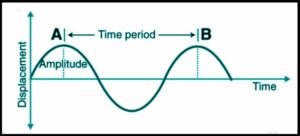Table of Contents
Periodic motion is characterized as a motion that repeats itself during regular intervals. A tuning fork or the motion of a pendulum are examples of periodic motion; if you analyze the motion, you’ll notice that the pendulum only passes through the mean position after a specific amount of time.
A Brief Outline
The motion described above can alternatively be classified as oscillatory. An oscillatory motion occurs when the body moves back and forth around a fixed point. As a result, an oscillatory motion could be periodic but is not required. So, using a wave motion as an example, we’ll look at various periodic motion properties.
Important concepts
The formula for Periodic Motion
(T) Time period: The time it takes for the motion to repeat itself is called the time period (T). A time period is measured in seconds.
(f) Frequency: It’s the number of times a motion is repeated in a single second. The frequency unit is Hz (Hertz). Frequency is linked to the time period in the following way:
f = 1/T
Is it just a basic harmonic motion? It’s a periodic motion with a relationship between restoring force and the deviation from the mean position. SHM is a type of oscillation wherein motion is carried out in a straight line between two extreme points. In basic harmonic motion, a restoring force can be seen as oriented towards the mean position or the equilibrium position. In simple harmonic motion, the mean position is a stable equilibrium.
A change is shown to be periodic if it occurs at regular intervals and in the same way each time. In the fields of research and predictive analysis, such periodic variations are of tremendous interest.

Significance of periodic motion in IIT JEE exam
Because the weighting for the periodic motion in the chapter is usually comparable between years, we can estimate that the simple harmonic motion is around 3.33 per cent. As a result, it’s expected that the total number of questions from this chapter would be around 2.
FAQs
Q. What is periodic motion, and how does it work?
Ans: Periodic motion is defined as a motion that repeats oneself at regular intervals of time.
Q. What is the definition of circular motion?
Ans: Circular motion is defined as the motion of an object while rotating in a circular path.
Q. What is the source of periodic motion?
Ans: A body goes in a straight line until a force is applied to it, according to Newton’s first law, the law of inertia. The same principle applies to bodies moving in a regular pattern. When a simple pendulum is pulled from its resting position (pulling is a type of force), it begins to move back and forth and tends to oscillate until the force is applied again.







